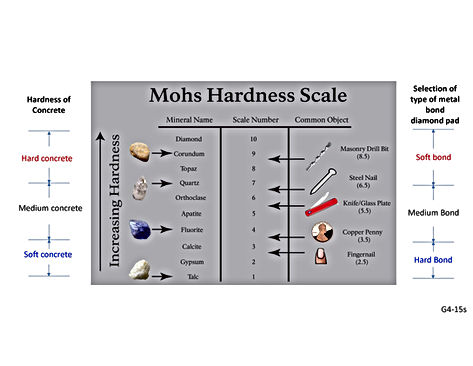Diamond-bonded segments are a type of abrasive tool that is commonly used in concrete grinding, polishing, and cutting applications. They are typically made of metal and are attached to the working surface of the tool. The diamond-bonded segments are made by bonding synthetic or natural diamonds onto the metal surface using a bonding material, such as metal or resin.
Diamond-bonded segments are used for a variety of concrete flooring applications, including removing surface coatings, grinding down rough or uneven concrete surfaces, polishing concrete to a high-gloss finish, and cutting concrete. The diamond abrasives provide a high level of cutting efficiency and durability, making them well-suited for heavy-duty concrete flooring applications.
Diamond-bonded segments are available in a variety of shapes, sizes, and bonding materials, and they can be custom designed to meet specific cutting and grinding requirements. When selecting diamond-bonded segments, it is important to consider the type of concrete you will be working with, the type of coating you will be removed, and the desired level of gloss for the finished surface.
What is the meaning of soft-bond and hard-bond of metal diamond segment pads?
-’Soft bond’ refers to the metallurgical powders that hold the abrasive material(diamond grit) that would wear fast enough to expose the cutting diamond fast enough.
-’Hard bond’ refer to the metallurgical powders that hold the abrasive material(diamond grit) would prolong wear to reduce the exposure of the cutting diamond.
How to install metal bond diamond segment.
Rules of Thumb when choosing metal diamond segment.
-Choose a metal hard bond diamond for a soft concrete floor.
-Choose a metal soft bond diamond for a hard concrete floor.
What do we mean by ‘Hard Concrete’?
-Mohs scale of 7 and above using Mohs Hardness Test Kit.
-Difficult to scratch or abrade.
What do we mean by ‘Soft Concrete’?
-Mohs scale of 3 and below using Mohs Hardness Test Kit.
-Easy to abrade.


 |  |  |
|---|---|---|
 |  |  |
 |  |  |
 |  |  |
 |  |
The Shape of Metal-Bond Diamond Segment
Metal bond diamond segments are designed in different shapes to optimize their performance for specific cutting or grinding applications. The shape of the segments plays a crucial role in determining the efficiency, precision, and overall effectiveness of the diamond tool. Here are some common shapes and their purposes:
Rectangular Segments:
These are versatile and commonly used for general-purpose cutting or grinding applications. Provide a good balance between cutting speed and surface finish. Suitable for a wide range of materials.
Trapezoid Segments:
Often used in concrete grinding applications.
The design allows for better access to corners and edges, making them ideal for surface preparation and coating removal. Arrow Segments:
Designed for fast and efficient grinding in concrete and other abrasive materials. The pointed shape enhances penetration and material removal.
Round Segments:
Ideal for aggressive grinding applications where a higher material removal rate is required. Effective for coating removal and surface preparation.
Single or Double Row Segments:
Used for applications that require a balance between material removal and a smooth finish. Double row segments often provide increased stability and longer life.
Cyclone Segments:
Have a unique shape with multiple segments radiating from a central point. Designed for fast and efficient grinding, especially in coatings and epoxy removal.
Wave Segments:
Designed to reduce friction and heat during grinding. Suitable for applications where preventing overheating is critical.
Hexagonal or Hexagon Segments:
Offer increased cutting or grinding efficiency due to their multiple edges. Suitable for aggressive material removal.
The choice of segment shape depends on factors such as the material being worked on, the desired finish, the speed of material removal, and the overall application requirements. Different shapes are engineered to address specific challenges and optimize performance for various tasks in industries such as construction, stone fabrication, and metalworking.
The number of Metal Bond Diamond Segments
The number of metal bond diamond segments in a tool, such as a grinding or cutting disc, can significantly impact its performance in terms of material removal rate, surface finish, and overall efficiency. The arrangement and quantity of segments play a crucial role in distributing the load, managing heat, and determining the tool's aggressiveness. Here are some considerations regarding the number of metal bond diamond segments:
Material Removal Rate:
Tools with more segments generally have a higher material removal rate. This is advantageous in applications where speed is essential, such as grinding down a concrete surface quickly.
Surface Finish:
Tools with fewer segments may provide a smoother surface finish. This is important in applications where achieving a polished or refined surface is critical, such as in the fabrication of stone countertops.
Heat Dissipation:
More segments can enhance heat dissipation, preventing the tool from overheating during prolonged use. This is particularly important when working on hard materials that generate a significant amount of heat.
Tool Stability:
A higher number of segments can contribute to better tool stability, reducing vibration and ensuring more even wear. This is especially beneficial for precision tasks and applications that require consistent results.
Aggressiveness:
Tools with a greater number of segments tend to be more aggressive, making them suitable for tasks that require rapid material removal. On the other hand, tools with fewer segments may be preferred for finer, more controlled work.
Contact Area:
The number of segments affects the contact area between the tool and the material. More segments distribute the force over a larger area, reducing the pressure on individual segments and contributing to longer tool life.
Application-Specific Considerations:
Different applications and materials may require specific segment configurations. For example, coatings removal might benefit from a tool with a high number of segments for efficient material removal, while a polishing task might require fewer segments for a smoother finish.
Ultimately, the choice of the number of metal bond diamond segments depends on the specific requirements of the application. Manufacturers and users consider factors such as material type, desired finish, speed of operation, and tool stability to select the optimal segment configuration for a given task.
